|
OTTOMAN EYALET OF DAMASCUS &
EYALET OF ALEPPO |
|
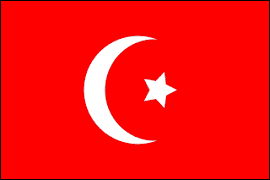
National Flag of the Ottoman
Empire • Early Nineteenth Century |
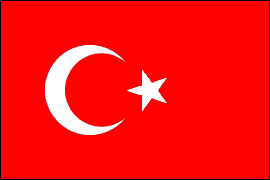
National Flag of the Ottoman
Empire in 1918 |
|

Ottoman Merchant
Ensign |
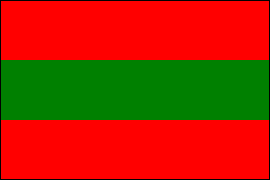
Ottoman Merchant
Ensign • Pilgrimage to Mecca |
|
The land that
was to become Syria was part of the Ottoman Empire until 1918.
Originally it was organized as a single large eyalet (province);
later it was divided in two: the Eyalet of Damascus and the Eyalet
of Aleppo. So far as is known these provinces had not distinctive
flags of their own. The Ottoman national flag was identical to the
current flag of Turkey. The merchant ensign was plain red or, for
masters of vessels who had made the pilgrimage to Mecca,
horizontally striped red-green-red.
|
|
THE ARAB REVOLT
& THE KINGDOM OF SYRIA • 1916-20 |
|
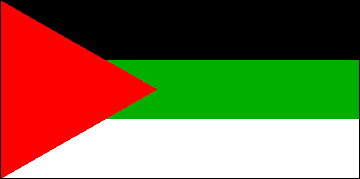
Flag of the Arab
Revolt |
|
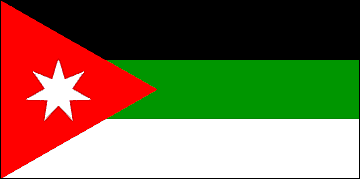
Kingdom of Syria •
National Flag |

Kingdom of Syria
• Royal Standard |
|
The Arab Revolt
against Ottoman rule began on June 10, 1916 at the behest of Sherif
Hussein bin Ali at Mecca. Its political aim was to throw out the
Turks and create a single Arab state from Aleppo in Syria to Aden in
Yemen. Also the Sherif accused the Young Turks, who dominated the
Ottoman government, of impiety in that many of their policies
violated Islamic law. For their part, the Turks accused the rebels
of betraying the Muslim Caliphate by siding with the European
imperialist powers who aspired to conquer and carve up Muslim lands
in their own interest. (As events would prove, the Turks had a
point.) The Revolt failed to attract widespread support, being
largely confined to the Arabian Peninsula and the tribes loyal to
Sherif Hussein. Arab forces to the number of some 5,000 did,
however, play a useful role in support of the British campaign that
led to the destruction of Ottoman power in the Middle East.
The flag of the
Arab Revolt, also called the Pan-Arab Flag, was a horizontal
tricolor of black, green and white stripes with a red triangle at
the hoist, these being colors long associated with Islam and the
Arabs. It was used by the Arab administration that was set up by the
British in Damascus after the ejection of the Turks from Syria and
in 1920 when an independent Kingdom of Syria was proclaimed with
Sharif Hussein’s son, Faisal bin Hussein, as king,
its national flag was the Arab Revolt Flag with a single white star
in the red triangle to signify independence. The kingdom, however,
lasted only a matter of months, the European powers having agreed
that Syria should become a League of Nations mandate territory under
French rule. |
|
THE FRENCH
MANDATE, THE SYRIAN FEDERATION & THE STATE OF SYRIA •
1920-32 |
|
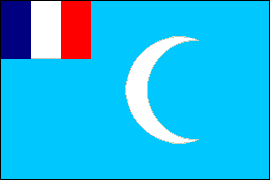
Mandate of Syria
• 1920-22 |
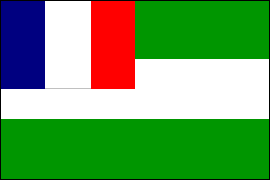
Syrian
Federation & State of Syria • 1922-32 |
|
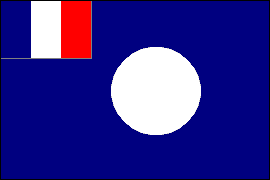
State of Damascus • 1920-24 |
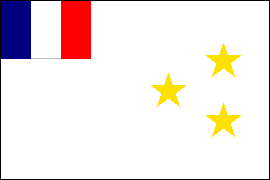
State of Aleppo •
1920-24 |
|
Under the terms of the mandate
(officially the Mandate for Syria and the Lebanon) Syria was,
supposedly, to be governed by France with an eye toward the
establishment of an independent state. In line with this requirement
the French created a Syrian Federation in 1922, reorganized and
renamed the State of Syria in 1924. The State united the previously
separate states of Damascus and Aleppo along with some other
territories to form what eventually became independent Syria. Though
the State enjoyed a certain autonomy there was widespread discontent
that led in 1925 to a revolt that was put down by the French Army with
exemplary brutality.
The flags used during this period
were of a colonial type, with a canton of the
French Tricolor. The
flag of the State of Syria was replaced in 1932 when the
constitution of the Syrian Republic came into effect. |
|
SYRIAN REPUBLIC, UNITED ARAB
REPUBLIC & SYRIAN ARAB REPUBLIC •
1932 TO THE PRESENT
|
|
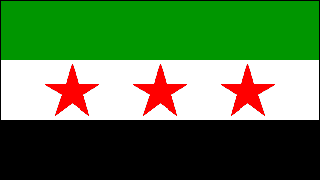
National Flag
• Syrian Republic • 1932-58
National Flag
• Syrian Arab Republic • 1961-63 |
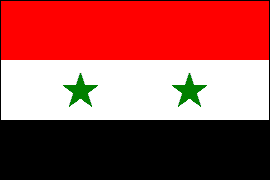
National Flag •
United Arab Republic • 1958-61
National Flag • Syrian
Arab Republic • Since 1980 |
|
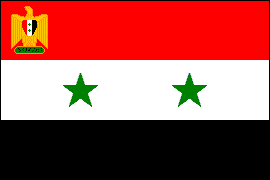
Presidential Flag •
United Arab Republic • 1958-61 |
|
The 1930 constitution of the Syrian Republic made provision for a
national flag: horizontal stripes of green, white and black, with
three red stars on the white stripe, thus restoring in a different
form the colors of the Arab Revolt flag. The three stars symbolized
the country's three regions: Damascus, Aleppo and
Deir ez Zor. It was officially hoisted for the first
time in 1932, when the Syrian Republic replaced the State of Syria.
Syria became independent in 1943 after the suppression of the Vichy
French administration, and the last French troops departed in 1946.
In 1958
Egypt and Syria signed a treaty of union. Thus was created the United Arab
Republic (UAR), a polity that it was hoped would eventually
encompass all Arab states. The flag of the new nation was a
horizontal red-white-black tricolor with two green stars for Egypt
and Syria on the white stripe. It thus merged the tradition of the Arab Liberation Flag with that of the-Arab
Revolt Flag. The coat of
arms of the UAR was the Eagle of Saladin with a shield striped
red-white-black bearing two green stars. These arms appeared in the
upper hoist of the presidential flag. The union proved unworkable
and Syria withdrew from it in 1961. |
|
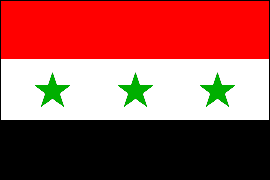
National Flag • Syrian Arab
Republic • 1963-72 |
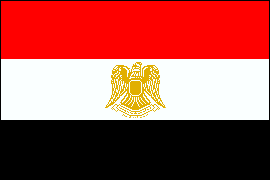
National Flag •
Syrian Arab Republic
Member State of the Federation of Arab
Republics 1972-80 |
|
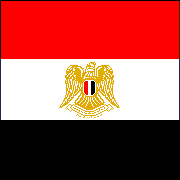
Presidential Standard •
Syrian Arab Republic •
1972-80 |
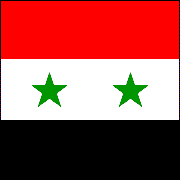
Presidential Standard •
Syrian Arab Republic • Since 1980 |
|
After leaving the UAR, Syria restyled itself as the
Syrian Arab Republic and readopted the 1932-58 flag. In 1963,
however, Army officers associated with the socialist Ba'ath Party
engineered a coup, one result of which was the adoption of yet
another national flag: essentially the UAR design but with three
green stars. These were said to symbolize the three basic principles
of the Ba'ath Party:
Freedom, Unity, Socialism. But nine years later when Syria joined the
Federation of Arab Republics, the 1963 flag was replaced. Under the
terms of the Federation all three member states (Egypt, Libya, Syria)
were to have the same flag: horizontal stripes of red, white and
black with the so-called
Hawk of Quraish on the white stripe. The Federation, like the UAR,
proved unworkable and was dissolved in 1977 but Syria continued to
use its flag until 1980 when as a nod to that elusive
ideal, Arab unity, it readopted the 1958-61 United Arab Republic
flag.
For the President of
Syria, two standard have been used. The first was based on the
Federation flag, with the shield on the hawk's breast striped in the
national colors. The second is simply a square version of the
current national flag. |
|
POLITICAL & OPPOSITION FLAGS
|
|
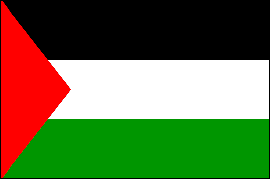
Ba'ath Arab Socialist Party |
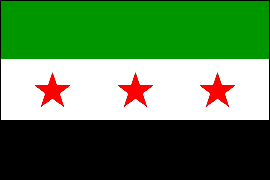
National
Coalition for Syrian Revolutionary and Opposition Forces |
|
The flag of the ruling Ba'ath Party is derived from the Arab Revolt
Flag and is very similar to the flag of the Palestinian Authority.
Various flags are used by opposition groups in Syria's bloody
civil war but most popular is the original flag of independent
Syria, with its green-white-black stripes and red stars. Some of
these flags are identical to the official 1932-58 design; others are
proportioned 2:3 like the current nationally flag and the stars are
smaller. It seems likely that if the Assad regime is ever deposed,
the 1923-58 flag or some variant thereof will become Syria's national flag. |



















